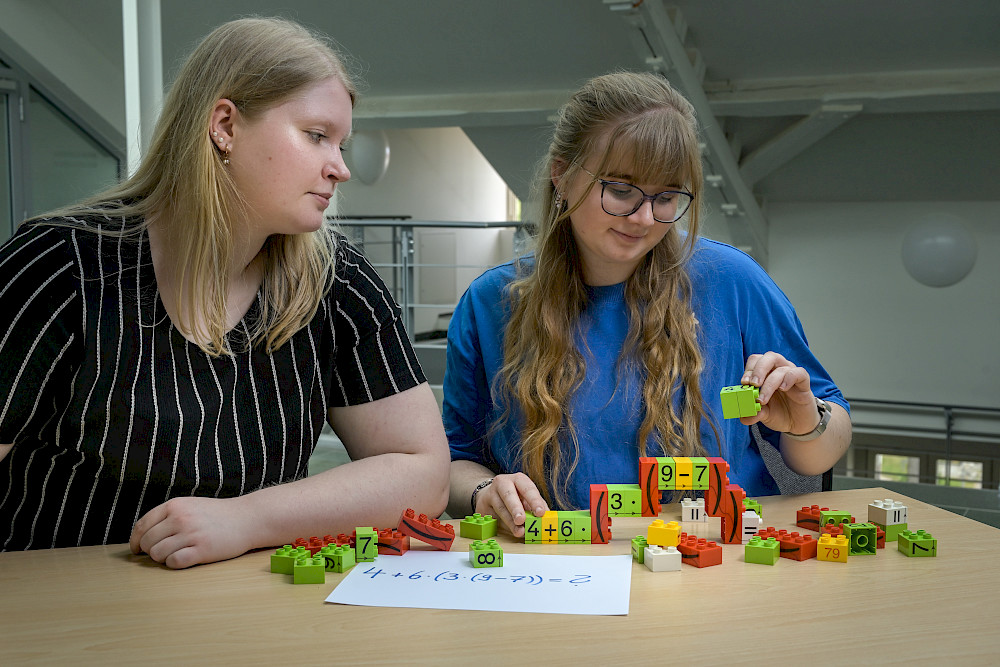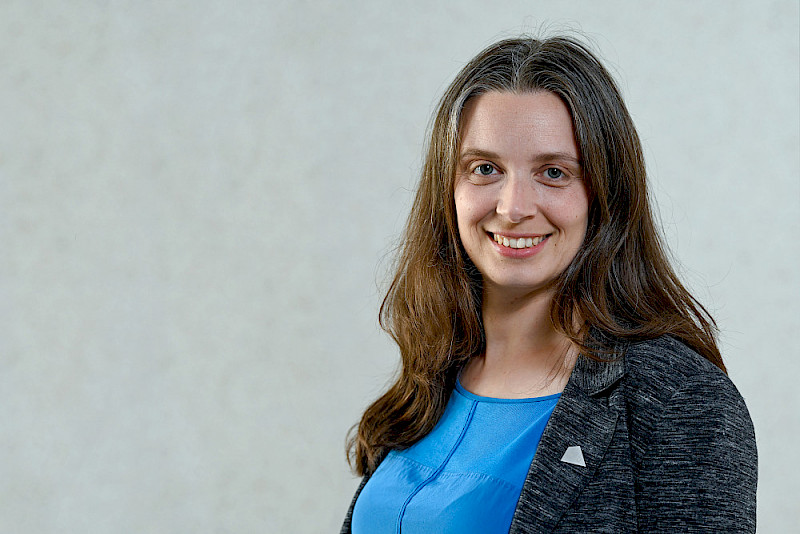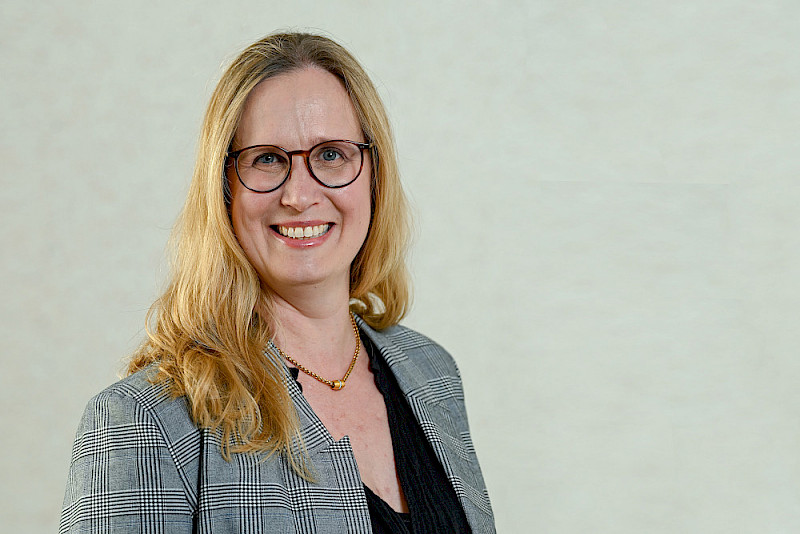Much more than just arithmetic

When the little robots get going in the mathematics didactics workshop, things can get colourful, a little loud and very educational. The “Ozobot”, for example, follows lines previously drawn with a pen and changes the colour of its lights in relation to the colour of the pen. But that’s not all: when the robot recognises certain colour sequences, it emits sounds, performs a dance, or spins around and heads back. There are also Bee-Bots, robots that look like bees that can be programmed at the touch of a button. “The robots are a fun way to illustrate what an algorithm is and how it works,” explains Dr Anna-Marietha Vogler, who works as a research assistant at the Chair of Mathematics Education Research run by Professor Kirstin Erath. An algorithm is a fundamental idea in mathematics; it is a clear instruction for solving a problem, including all of the sub-steps. With the small robots, for example, it tells them to cover a certain distance and, ideally, not to fall off the table.
Algorithms are used everywhere in maths, for example in solving equations. One could stand in front of a classroom of pupils and explain this and then hope that they understand. But: “You don’t learn maths by only observing or by just having someone tell you something,” says Kirstin Erath. “Good maths instruction is not a one-way street. It is not quiet. Instead, it activates the children and adolescents. There is a lot of interaction between the teacher and the class as well as among the pupils themselves. Everyone should be involved.”
Understanding instead of just practicing
This basic assumption is part of a step-change in maths instruction. A few decades ago, the aim was still, first and foremost, for pupils to learn to calculate. “This is no longer necessary to the same extent today. Now it’s more about encouraging critical thinking,” says Erath. This means working on topics together with the pupils and taking their ideas seriously. “Even on the first day of school, pupils aren’t coming to class as blank slates. They have a lot of previous experience, including maths experience, which they can build on,” says Vogler.
Talking about maths does not require pupils to memorise special vocabulary. “Good teaching always starts by referring to something in everyday life. Specialist vocabulary is only needed at a more abstract level, but this develops by speaking with the pupils.” The aim of teaching should not only be for children to understand maths as a discipline, it is also important for them to learn to understand and shape their world. And that they acquire the necessary skills for this, such as recognising patterns or solving real-world problems using mathematical methods. Erath and Vogler call this “connectable learning” and “application-ready knowledge”. For example, one of their university students had pupils measure fine-particulate air pollution in the classroom for an academic term paper. This not only taught the children how to collect data and calculate various parameters, but also critical thinking skills.
And there is another reason why the two researchers focus less on arithmetic and more on speaking, reasoning and discussion: it’s more helpful. This has been shown, for example, by a study that Erath conducted together with researchers from Dortmund and Kiel. In an intervention study involving nearly 600 children and adolescents, they were able to prove that the pupils’ comprehension of maths and their maths skills improve when mathematical ideas are discussed more in class. The findings from this research are consistently incorporated in lectures at the Institute of Mathematics.
Daring to be more flexible
Erath’s team offers three modules to prospective maths teachers as part of MLU’s teacher training programme. They provide a mixture of subject-related didactic expertise and meta-knowledge, which helps with planning and reflecting on lessons as well as performance assessment. This also includes learning about different methods of imparting knowledge and recognising when to use which method. In geometry, for example, mathematical concepts can be visualised by folding and cutting paper, or working on a screen using special software.
The lectures often go back to basics: “At the beginning, we discuss with our students what maths actually is. Mathematics needs to be regarded less as a fixed canon of knowledge that has been discovered or created by individuals in isolation. Instead, knowledge of mathematics is built on interactions between participants and is characterised by its flexibility, for example, in solving problems,” says Vogler. An understanding of this is necessary when preparing future teachers for this different way of teaching maths.
“Our students have often excelled under a more traditional form of teaching – otherwise they wouldn’t be here. We have to work with these traditional experiences and sensitise students to the fact that the lessons that worked for me may not have worked for others. Every child comes with different prerequisites and good teaching needs to take these into account,” explains Erath.
Students can try all of this out for themselves as part of various school internships and the compulsory in-school work placements. The idea is for prospective teachers to gain their first experience of teaching while still at university and under the intensive supervision of their lecturers. This includes seminars on how to plan lessons, shadowing, teaching their first lesson and a follow-up evaluation. “It’s very time-consuming for everyone involved, but it’s a real opportunity. We guide our students as they put their knowledge to the test and lay a good foundation. Something like this is rare in other federal states,” says Erath.
The demands on the teachers of the future are high. “In my lectures, I start by explaining to the students the ideal type. I call them ‘unicorns that dance on rainbows,’” says Erath and laughs. During the in-school work placement and other school internships, the aim is then to merge these ideals with reality – without falling into traditional patterns. “Of course, not everything is always possible. Maybe the rainbow has to go, but there are still dancing unicorns!”
Because one year group can have two classes that are very different, it is necessary to make flexible, didactically sound decisions for the respective lessons, says Anna-Marietha Vogler. “There are no universal teaching templates – even if many sites on the Internet suggest that there are. It is helpful to be able to analyse critically and develop oneself further.” Student teachers therefore also need “flexible, application-ready didactic knowledge” for their future careers. This is the only way to react confidently to new challenges and issues, adds Kirstin Erath, who is certain that “maths lessons will work much differently in ten years’ time than they do today.”
Artificial intelligence and digital media have also been covered in her courses for some time. “In Saxony-Anhalt, the topic of education in the digital world is part of the maths curriculum and is therefore compulsory,” says Vogler happily. The aim is to use digital media to explain maths in a different way.
Artificial intelligence will become even more front and centre in the future, says Vogler, because it can take over entire processes. The role of maths lessons would therefore be to encourage critical thinking about these processes and, for example, teach the skills needed to solve problems using AI. Of course, this also includes knowing which calculations could be helpful in solving a specific everyday mathematical problem and then applying them.
Since 2022, the researchers have also been imparting their knowledge to teachers in Saxony-Anhalt as part of continuous education courses. This year, around 100 teachers came to the Institute of Mathematics. “I was particularly pleased to hear that they can easily integrate our suggestions into their own lessons,” says Erath. Research in – and development of – continuous education for teachers is also at the centre of an international project that Erath is carrying out in partnership with the University of Oxford.
Prof. Dr. Kirstin Erath
Institute of Mathematics
phone +49 345 55-24612
mail kirstin.erath@mathematik.uni-halle.de
Further articles
Teaching in the future
Bee robots instead of whole class instruction: the University of Halle is preparing its student teachers for modern ways of working in schools. Read more



